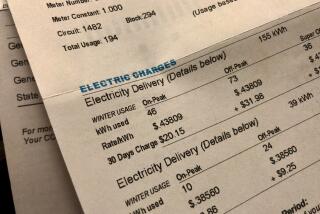Verizon Ordered to Cut Rates for Rivals
California regulators on Thursday slashed prices that competitors must pay Verizon Communications Inc. for key parts of its telephone network, a move designed to jump-start competition in territories covered by the state’s second-largest local carrier.
The interim rates set by the state Public Utilities Commission bring Verizon’s wholesale prices in line with those the agency adopted in May for SBC Communications Inc., the state’s dominant phone company. The changes took effect immediately and reduced by 31% to 60% the wholesale prices Verizon charges for access to its local phone equipment.
Consumer advocates and other phone companies hailed the decision, saying it would open up Verizon’s 6.3 million lines to much-needed competition. Although it has rivals for business customers in areas such as downtown Long Beach and the Wilshire district, Verizon has held a monopoly on home phone lines in its California markets.
Verizon’s California territories include Los Angeles’ west and South Bay areas, Long Beach and other beach communities from northern Orange County to Santa Barbara.
“With this decision, we will be entering the market as soon as possible,” said Kenneth T. McNeely, president of AT&T; California. “We’ll see substantial discounts on features like call-waiting ... where the local carrier makes the most money.”
The 4-1 PUC vote was a blow to Verizon, which long has been permitted to charge significantly higher wholesale and retail rates than SBC.
“We’re very disappointed with the decision,” said Phil Cleverly, the company’s state director for regulatory affairs.
The order “forces Verizon to provide access at rates that are well below the cost of providing service,” said Tim McCallion, Verizon’s Pacific region president. “Under this decision Verizon pays AT&T; and WorldCom to compete in California.”
The commission cut the wholesale price 37% to $10.56 a month for leasing the biggest component of Verizon’s network: each loop of copper wire that connects homes and businesses to the carrier’s central switching offices. The cost of less expensive Verizon equipment, such as the switches that connect calls, went down 31% to 60%. For the complete package some companies need to provide monthly service, the wholesale rate was cut 44% to $16.08 a month.
Verizon is considering its options, including a court challenge and a request for a rehearing before the PUC, Cleverly said.
Wall Street analyst Vik Grover at Kaufman Bros. in New York said Verizon ought to consider trying to compete before it is overwhelmed by rivals. Otherwise, he said, it could face a “death sentence.”
“With their monopolies, the Bells are some of the most profitable companies around,” he said. “But now they have to get competitive. They’ve got to stop crying and moaning.”
Investors didn’t seem concerned. Verizon’s stock gained $1.28 to close at $34.75 on the New York Stock Exchange.
The PUC faulted Verizon for sticking to a pricing method that predated the 1996 federal Telecommunications Act and failing to follow a federal pricing formula for its network parts, said Commissioner Geoffrey F. Brown. Instead of complying with the federal formula, the company simply offered a discount on current prices.
“Verizon still has a profit margin that it can make off [wholesale] customers that SBC cannot make,” Brown said.
The carrier had sought to keep the wholesale price for loops from going below $14.27. It also had proposed to cut the wholesale price of the complete package by 28%, to $20.52.
Verizon has charged competitors much more than the $17.25 its residential customers pay, but Cleverly said wholesale rates have to cover all the features for which consumers are charged separately, such as call waiting.
Interim rates will remain until the commission conducts a proceeding to set permanent rates, a process expected to conclude a year from now. SBC’s rates are to be set this spring.
Verizon controls about 25% of all the phone lines in California and about 18% of the state’s residential lines. SBC controls nearly 70%, or about 17 million, of the state’s 25 million lines.
More to Read
Inside the business of entertainment
The Wide Shot brings you news, analysis and insights on everything from streaming wars to production — and what it all means for the future.
You may occasionally receive promotional content from the Los Angeles Times.










